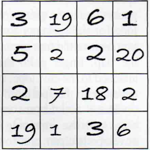 All this week, the news has been sent around the world about a 16-year-old Iraqi-born teen, currently living in Sweden, who solved a 300-year-old math puzzle.
All this week, the news has been sent around the world about a 16-year-old Iraqi-born teen, currently living in Sweden, who solved a 300-year-old math puzzle.
Most of the write-ups are variations of the AFP story originally published with the headline, Iraq-born teen cracks maths puzzle:
A 16-year-old Iraqi immigrant living in Sweden has cracked a maths puzzle that has stumped experts for more than 300 years, Swedish media reported on Thursday.
In just four months, Mohamed Altoumaimi has found a formula to explain and simplify the so-called Bernoulli numbers, a sequence of calculations named after the 17th century Swiss mathematician Jacob Bernoulli, the Dagens Nyheter daily said.
Altoumaimi, who came to Sweden six years ago, said teachers at his high school in Falun, central Sweden were not convinced about his work at first.
"When I first showed it to my teachers, none of them thought the formula I had written down really worked," Altoumaimi told the Falu Kuriren newspaper.
He then got in touch with professors at Uppsala University, one of Sweden's top institutions, to ask them to check his work.
After going through his notebooks, the professors found his work was indeed correct and offered him a place in Uppsala.
But for now, Altoumaimi is focusing on his school studies and plans to take summer classes in advanced mathematics and physics this year.
"I wanted to be a researcher in physics or mathematics; I really like those subjects. But I have to improve in English and social sciences," he told the Falu Kuriren.
More details about this story can be found at the Personal Money Store write-up of the story, Amazing 16-Year-Old Finds Bernoulli Numbers Relationship.
If you're not familiar with Bernoulli numbers, the clearest explanation I've found of them is over at The Straight Dope, where the concept of Bernoulli numbers is discussed in detail.






 In this edition of snippets, we're going to fold, spindle and mutilate your brains in as many fun ways as possible!
In this edition of snippets, we're going to fold, spindle and mutilate your brains in as many fun ways as possible!




